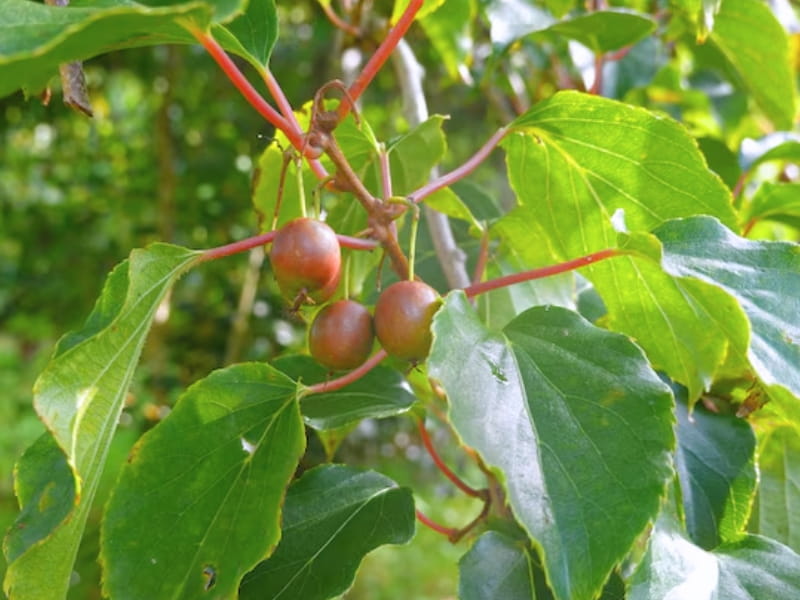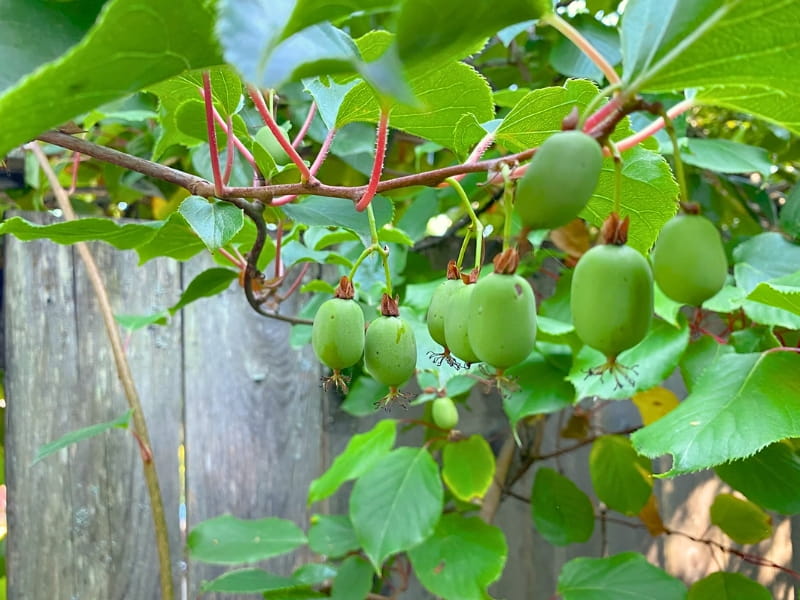Hardy Kiwi Vine, also known by common names like arctic kiwi, baby kiwi, or Actinidia arguta and Actinidia kolomikta, is a remarkable plant offering the delightful sweetness of traditional kiwifruit without the fuzzy skin. These vigorous, cold-tolerant vines produce an abundance of small, grape-sized fruits that are perfect for snacking, salads, or even jams. At Gardencenterpoint.com, we celebrate the versatility and resilience of this often-overlooked gem.
This comprehensive guide will reveal everything you need to know to successfully cultivate your own Hardy Kiwi Vine. From selecting the right variety for your climate to mastering essential pruning techniques, we’ll provide you with the knowledge and confidence to enjoy a bountiful harvest. We will also discuss in this article, detailed instructions on how to grow hardy kiwi vines, including soil preparation, watering, and fertilization. A section is dedicated to hardy kiwi vine care guide, covering pest and disease management, and winter protection. Keep reading to unlock the secrets of this incredible fruit and transform your garden! For those wanting to start right away, we also touch on where to buy hardy kiwi vine plants.

Hardy Kiwi Vine: An Overview and Its Many Advantages
The Hardy Kiwi Vine (primarily Actinidia arguta and Actinidia kolomikta) is a deciduous, perennial vine native to regions of East Asia, including Japan, Korea, China, and Siberia. Unlike its larger, fuzzier cousin, the kiwifruit (Actinidia deliciosa) commonly found in supermarkets, the hardy kiwi produces smooth-skinned, smaller fruit, typically about the size of a large grape or cherry. This characteristic makes them incredibly convenient for eating fresh, as there’s no need for peeling.
| Common name | Hardy Kiwi, Arctic Kiwi, Baby Kiwi, Dessert Kiwi, Cocktail Kiwi |
| Botanical name | Actinidia arguta, Actinidia kolomikta (most common species) |
| Family | Actinidiaceae |
| Genus | Actinidia |
| Species | arguta, kolomikta, and others |
| Origin | East Asia (Japan, Korea, China, Siberia) |
| Native | Not native to USA, but widely adaptable |
| Life cycle | Perennial |
| Plant type | Deciduous, woody vine |
| Hardiness zone | 3-8 (depending on species and variety; A. kolomikta generally hardier than A. arguta) |
| Sunlight | Full Sun (at least 6-8 hours per day), tolerates partial shade (but fruit production may be reduced) |
| Maintenance | Moderate (primarily pruning) |
| Water | Moderate (consistent moisture, but well-drained) |
| Drainage | Well-Drained (essential) |
| Soil pH | Slightly acidic (6.0-6.5 ideal) |
| Spacing | 10-15 feet between female plants; male plant within 50 feet |
| Flowering period | Late Spring to Early Summer |
| Fruiting Period | Late Summer to Fall. |
| Height | 10-30+ feet (depending on support and pruning) |
| Growth rate | Fast (can grow several feet per year) |
| Flower color | White or creamy white, sometimes with a hint of green |
| Stem color | Brown, reddish-brown |
| Flower benefit | Attracts pollinators (bees, butterflies) |
| Fruit Characteristics | Small (grape-sized), smooth skin, sweet flavor, green, red, or brownish skin depending on variety. |
| Garden style | Edible landscaping, cottage gardens, vertical gardens |
| Uses | Fresh eating, salads, smoothies, jams, jellies, desserts, ornamental vine, privacy screen, shade |
| Propagation | Seed, cuttings, layering, grafting |
| Pest and disease | Generally resistant, but monitor for Japanese beetles, spider mites, root rot. |
| Pollination | Usually dioecious (separate male and female plants required); some self-fertile cultivars exist (e.g., ‘Issai’). |
| Special Notes | Requires a sturdy support structure (trellis, arbor, pergola). Regular pruning is essential for fruit production and managing growth. |
The advantages of growing hardy kiwi vines extend far beyond their convenient size. They are exceptionally cold-hardy, with some varieties tolerating temperatures as low as -30°F (-34°C) or even lower. This makes them suitable for cultivation in a much wider range of climates than traditional kiwifruit. They are also relatively pest and disease-resistant, reducing the need for chemical interventions. Furthermore, the vines themselves are visually appealing, with attractive foliage and, in some cases, colorful variegation (Actinidia kolomikta varieties are particularly known for their pink and white splashes on the leaves).
The flavor of hardy kiwis is often described as sweeter and more complex than that of the common kiwifruit. They have a tropical taste with hints of pineapple, banana, and strawberry, depending on the variety. The fruits are rich in vitamins, particularly Vitamin C, Vitamin K, and Vitamin E, as well as antioxidants and dietary fiber. A study published in the Journal of the Science of Food and Agriculture highlighted the high antioxidant activity of hardy kiwis, suggesting potential health benefits.
The vines can be trained onto trellises, arbors, pergolas, or fences, making them a versatile addition to any garden landscape. They can be used to create shade, privacy screens, or simply as a beautiful ornamental feature. The rapid growth rate of the vines means that they can quickly cover a structure, providing a lush, green backdrop. However, this vigorous growth also necessitates regular pruning to keep the vines manageable and productive.
Another important consideration is that most hardy kiwi vines are dioecious, meaning that separate male and female plants are required for fruit production. One male vine can typically pollinate up to eight female vines. However, some self-fertile varieties, such as ‘Issai’, exist, although even these often benefit from cross-pollination with a male vine. It’s crucial to understand this requirement when planning your hardy kiwi planting. The ‘Issai’ variety, while self-fertile, is known to produce smaller fruit and may have lower yields compared to cross-pollinated dioecious varieties.
Choosing the Right Hardy Kiwi Vine Variety: A Comprehensive Guide
Selecting the right hardy kiwi variety is crucial for success, as different cultivars vary in their cold hardiness, fruit size, flavor, and ripening time. Here’s a breakdown of some popular and reliable options:
| Variety | Species | Cold Hardiness (USDA Zone) | Fruit Size & Flavor | Notes |
| ‘Ananasnaya’ | Actinidia arguta | 4-8 | Large, green fruit; sweet, pineapple-like flavor | Very popular, vigorous grower; also known as ‘Anna’ |
| ‘Geneva’ | Actinidia arguta | 4-8 | Medium, green fruit; sweet and aromatic | Early ripening, reliable producer |
| ‘Issai’ | Actinidia arguta | 5-8 | Small, green fruit; sweet flavor | Self-fertile, but benefits from cross-pollination; less vigorous than others |
| ‘Ken’s Red’ | Actinidia arguta | 4-8 | Medium, red-blushed fruit; sweet, slightly tart | Attractive red color, good flavor |
| ‘Arctic Beauty’ | Actinidia kolomikta | 3-8 | Small, green fruit; sweet, intense flavor | Known for its variegated foliage (pink and white); very cold-hardy |
| ‘Krupnopladnaya’ | Actinidia arguta | 4-8 | Large size fruit; Sweet. | Developed by a breeder in Kyiv, Ukraine. |

Important Considerations When Choosing a Variety:
- Cold Hardiness: Ensure the variety you choose is suitable for your USDA Hardiness Zone. Gardencenterpoint recommends consulting your local extension office for specific zone information.
- Pollination: Remember that most varieties require a separate male vine for pollination. Plan your planting accordingly. If space is limited, consider ‘Issai’, but be aware of its potential drawbacks.
- Ripening Time: Different varieties ripen at different times, typically from late summer to early fall. Consider your local climate and growing season length.
- Fruit Size and Flavor: While all hardy kiwis are generally sweet, some have nuances in flavor and size. Read descriptions carefully and, if possible, sample fruit from different varieties before planting.
- Vine Vigor: Some will require larger support and trellising systems than others.
Planting Your Hardy Kiwi Vine: Step-by-Step Instructions
Once you’ve selected your hardy kiwi varieties, proper planting is essential for establishing healthy, productive vines.
- Timing: The best time to plant hardy kiwi vines is in the spring after the last frost, or in the early fall, giving the plants time to establish roots before winter.
- Location: Choose a sunny location that receives at least 6-8 hours of direct sunlight per day. While hardy kiwis can tolerate some shade, fruit production will be reduced. The site should also have well-drained soil. Avoid areas with heavy clay or standing water.
- Soil Preparation: Hardy kiwis prefer slightly acidic soil with a pH of 6.0-6.5. Amend the soil with compost or other organic matter to improve drainage and fertility. A soil test is recommended to determine the pH and nutrient levels, allowing for targeted amendments.
- Support Structure: Provide a sturdy support structure, such as a trellis, arbor, or pergola, before planting. The vines will need something to climb on, and it’s much easier to install the structure before the plants are in place. A T-bar trellis system is commonly used, with horizontal wires spaced about 18-24 inches apart.
- Planting: Dig a hole that is twice as wide and as deep as the root ball of the plant. Gently loosen the roots before placing the plant in the hole. The top of the root ball should be level with the surrounding soil surface. Backfill the hole with soil, tamping it down gently to remove air pockets.
- Spacing: Space female vines 10-15 feet apart, and plant the male vine within 50 feet of the female vines.
- Watering: Water the newly planted vines thoroughly. Keep the soil consistently moist, but not waterlogged, during the first growing season.
- Mulching: Apply a 2-3 inch layer of organic mulch, such as wood chips or shredded bark, around the base of the plants. This helps to conserve moisture, suppress weeds, and regulate soil temperature. Keep the mulch a few inches away from the stems to prevent rot.
Hardy Kiwi Vine Care: Watering, Fertilizing, and Pruning
Watering:
Consistent watering is crucial, especially during the first few years while the vines are establishing their root systems. Aim to keep the soil consistently moist, but not waterlogged. The amount of water needed will depend on rainfall, temperature, and soil type. As a general guideline, provide about 1 inch of water per week, either through rainfall or irrigation. During hot, dry periods, you may need to water more frequently. Deep watering, less frequently, is better than shallow watering, more often, as it encourages deeper root growth.
Fertilizing:
Hardy kiwis are moderate feeders. A balanced fertilizer, such as a 10-10-10 formula, can be applied in the spring before new growth begins. Alternatively, use a slow-release organic fertilizer. Avoid over-fertilizing, as this can lead to excessive vegetative growth at the expense of fruit production. A soil test can help determine the specific nutrient needs of your soil. Compost or well-rotted manure can also be applied as a top dressing in the spring to provide nutrients and improve soil health.
Pruning:
Pruning is essential for maintaining the health and productivity of hardy kiwi vines. It’s best to prune during the dormant season, typically in late winter or early spring before bud break. The goals of pruning are to:
- Maintain a manageable size and shape.
- Remove dead, damaged, or diseased wood.
- Encourage fruiting wood.
- Improve air circulation.

Pruning Technique (T-bar Trellis System):
- Establish a Central Leader: Select a strong, upright shoot to be the central leader. Tie it to the top wire of the trellis.
- Develop Lateral Arms: Select two strong shoots on either side of the central leader and tie them to the horizontal wires. These will become the permanent lateral arms.
- Fruiting Spurs: Shorten the lateral arms to about 4-6 feet in length. Side shoots (fruiting spurs) will develop along the lateral arms. These spurs will produce the fruit.
- Renewal Pruning: Each year, prune back the fruiting spurs to 2-3 buds. This encourages new growth and fruit production. Also, remove any weak or crossing branches.
- Summer Pruning: Summer pruning might be needed to help tame vine growth.
- Male Vine Pruning: Male vines can be pruned more severely than female vines, as they only need to produce pollen. Prune them after flowering to keep them from overwhelming the female vines.
Pest and Disease Management for Hardy Kiwi Vines
While hardy kiwis are generally resistant to pests and diseases, there are a few potential problems to watch out for:
- Japanese Beetles: These beetles can skeletonize the leaves of hardy kiwi vines. Hand-picking, traps, or insecticidal soap can be used to control them.
- Spider Mites: These tiny pests can cause yellowing and stippling of the leaves. They thrive in hot, dry conditions. Insecticidal soap or horticultural oil can be effective.
- Phytophthora Root Rot: This fungal disease can occur in poorly drained soils. Symptoms include wilting, yellowing, and stunted growth. Prevention is key: ensure good drainage and avoid overwatering.
- Botrytis Fruit Rot: This fungal disease can affect the fruit, causing it to rot. It is more common in humid conditions. Good air circulation and proper pruning can help prevent it.
Harvesting and Storing Your Hardy Kiwis
Hardy kiwis typically ripen in late summer to early fall, depending on the variety and your climate. The fruit will soften slightly and develop its full color when ripe. You can also test for ripeness by gently squeezing the fruit; it should give slightly to pressure.
Unlike traditional kiwifruit, hardy kiwis do not need to be peeled before eating. Simply wash them and enjoy! They can be eaten fresh, added to salads, smoothies, or used to make jams, jellies, or desserts.
Hardy kiwis can be stored in the refrigerator for several weeks. For longer storage, they can be frozen. Whole frozen kiwis can be used in smoothies, while sliced or pureed kiwis can be used in baked goods or other recipes.

Leave a Reply